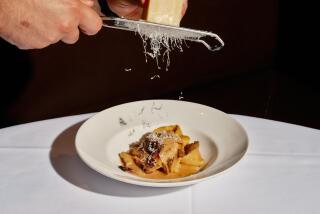FOOD & WINE : Extra-Virgin High-Test : Some Fancy Olive Oils Are as Flavorful and as Expensive as Fine Wines
WHEN COLD WEATHER comes to Italy, the bright colors fade. Even in Umbria, which calls itself “The Green Heart of Italy,” the landscape looks stripped, brown and barren. Golden persimmons hang from skeletal tree branches. And, once again, Alfredo Mancianti is tending his olive oil.
Mancianti owns two groves of olive trees near the Umbrian town of San Feliciano, a summer resort on the shores of Lago Trasimeno. In winter, the town stands shuttered. The little sailboats are beached, and the water looks cold.
Inside the stone-walled Mancianti frantoio , half a dozen men, dressed in the traditional blue jumpsuits of Italian laborers, work on what may well be the most highly touted olive oil in all Italy.
Mancianti’s Affiorato retails for $28.50 per half liter at Santa Monica’s Broadway Deli, and that’s no aberration. In Milan’s La Republica newspaper, under the headline “From San Feliciano an Oil Priced Like Champagne,” a story rhapsodized that Affiorato is “like a Rolls Royce--outside category.”
Noted Italian food writer Gianni Mura rated the Top 10 olive oils and heralded Affiorato as the best in Umbria.
When extra-virgin olive oils turn up on the shelves of ordinary supermarkets, oils such as Affiorato are sold like fine wine. Estate-bottled oils, vintage-dated oils, oils from specific orchards in hand-numbered bottles--all are signs that the super-premium oil market is booming.
“We are seeing more and more demand and, therefore, more and more producers taking olive oil much more seriously,” says Piero Selvaggio, owner of Valentino and Primi restaurants in Los Angeles and a man who takes olive oil seriously enough to offer diners an appetizer sampling of four different varieties with toast.
“I think olive oil is a lot like Italian food in general. It has been sloppily prepared and poorly executed for too long,” Selvaggio says. “Now there is a call for a better product, an oil with a better extraction of flavors, and that leads you right to single vineyards and to the miracle of Affiorato.”
The “miracle” of Affiorato comes from the care with which it is made. While extra-virgin oils are pressed only once, Affiorato is never pressed at all. Mancianti uses a stone wheel to slowly grind the olives, releasing the oil. The very lightest oil floats to the top, where it is siphoned into 400-liter amphorae dating from the 1800s.
Mancianti makes only 35,000 liters a year--including Affiorato, two single-vineyard oils (San Feliciano, made from 50-year-old Agogia and Moraiolo trees, and Monte del Lago, made from 100-year-old Raggiola Secolare trees) and a regular extra-virgin. Only 1,900 liters of Affiorato are made--from the best olives from both locations.
Such oils are expensive (though, certainly, few are as pricey as Affiorato) and should be used with discretion. Actually cooking with one is absurd; one would no more fry an eggplant in Affiorato than stew a chicken in Chateau Lafitte. Instead, use these oils like fine-quality butter. Brush grilled bread with a little oil and you have bruschetta. Or bathe already-cooked vegetables or grilled meats with oil just before serving. A drizzle added to a soup or sauce just before serving can make an enormous improvement. Use these oils in ways that make maximum use of their fresh, vivid fragrances and flavors.
“This is something pure, and it should be used with simple, exquisite food,” says Selvaggio. “Bread and Affiorato can make a lunch.”
This recipe is adapted from a dish served at Primi restaurant. Be sure to adjust seasonings at the end; the white beans really absorb salt, and if there isn’t enough, the olive oil flavor will seem flat. Spice up any leftovers with some fennel sausage, shredded Swiss chard leaves and grated Parmesan cheese.
PRIMI’S ZUPPA DI FAGIOLI
2 cups dried canellini beans or other small white beans, soaked 8 hours or overnight1 bay leaf2 tablespoons extra-virgin olive oil1 onion, finely chopped3 cloves garlic, chopped1 stalk celery, finely chopped1 carrot, finely chopped1/4 cup Italian parsley, finely chopped2 cups tomatoes, peeled, seeded and choppedSalt and pepper to taste2 cups cooked orzo, tiny maccheroni or rice6 tablespoons extra-virgin olive oil Drain beans and place in saucepan or Dutch oven. Add water to cover, about 1 quart. Add bay leaf, cover and bring to boil. Lower heat and let simmer 1 hour.
Heat 2 tablespoons extra-virgin olive oil in skillet and add onion, garlic, celery, carrot and parsley. Simmer over medium heat. When onion starts to brown, add tomatoes and continue simmering 15 minutes. Add onion mixture to bean pot; cover pot and cook over low heat 1 hour or until beans are tender. Check every 20 minutes, adding water as needed. Season to taste with salt and pepper.
In each serving bowl, place 2 tablespoons pasta or rice; add beans and broth. Let cool; when just above room temperature, serve each bowl garnished with 1 tablespoon oil. Makes 6 servings.
NOTE: In Florentine tradition, oil replaces grated cheese.
More to Read
Eat your way across L.A.
Get our weekly Tasting Notes newsletter for reviews, news and more.
You may occasionally receive promotional content from the Los Angeles Times.











